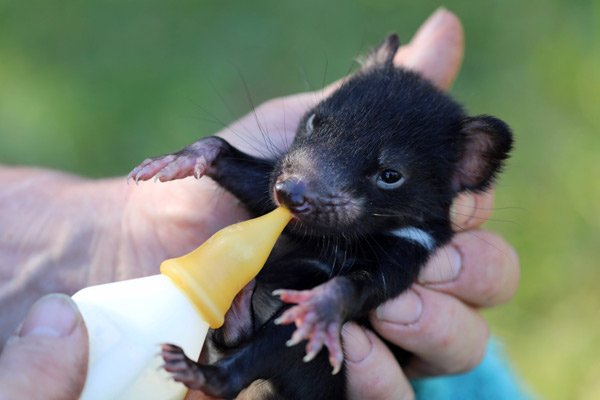Tasmanian devils make a comeback
The animals have been released into the wild 3000 years after the feisty marsupials went extinct there
Updated On - 6 October 2020, 05:21 PM
Tasmanian devils have been released into the wild on Australia’s mainland 3,000 years after the feisty marsupials went extinct there, in what conservationists described Monday as a “historic” step. Aussie Ark, along with a coalition of other conservation groups, revealed Monday that they had released 26 of the carnivorous mammals into a 400-hectare (1,000-acre) sanctuary at Barrington Tops, about 3.5 hours north of Sydney. After 16 years of work, including the establishment of mainland Australia’s largest Tasmanian devil breeding programme, Faulkner said it was “incredible and surreal” to have reached the goal.
 Tasmanian devil, the famously feisty mammals have a coat of coarse brown or black fur and a stocky profile that gives them the appearance of a baby bear. Most have a white stripe or patch on their chest and light spots on their sides or rear end. They have long front legs and shorter rear legs, giving them a lumbering, piglike gait.
Tasmanian devil, the famously feisty mammals have a coat of coarse brown or black fur and a stocky profile that gives them the appearance of a baby bear. Most have a white stripe or patch on their chest and light spots on their sides or rear end. They have long front legs and shorter rear legs, giving them a lumbering, piglike gait.
The Tasmanian devil is the world’s largest carnivorous marsupial, reaching 30 inches in length and weighing up to 11 kgs, although its size will vary widely depending on where it lives and the availability of food. Its oversize head houses sharp teeth and strong, muscular jaws that can deliver, pound for pound, one of the most powerful bites of any mammal.
Habitat
Once abundant throughout Australia, Tasmanian devils are now found only on the island state of Tasmania. Their Tasmanian range encompasses the entire island, although they are partial to coastal scrublands and forests.
Diet and behavior
Tasmanian devils are strictly carnivorous, surviving on small prey such as frogs, birds, fish, and insects. They prefer scavanging to hunting and frequently feast communally on carrion. They are at their most rowdy when jockeying for position on a large carcass. Like other marsupials, when they are well-fed, their tails swell with stored fat.
Devils are solitary and nocturnal, spending their days alone in hollow logs, caves, or burrows, and emerging at night to feed. They use their long whiskers and excellent sense of smell and sight to avoid predators and locate prey and carrion.
Reproduction
Mothers give birth after about three weeks of pregnancy to 20 or 30 very tiny young. These hairless, raisin-size babies crawl up the mother’s fur and into her pouch. However, the mother has only four nipples, so only a handful of babies survive. Infants emerge from the pouch after about four months, are generally weaned by the sixth month, and on their own by the eighth.
Threats to survival
Efforts in the late 1800s to eradicate Tasmanian devils—considered to be livestock-killing pests—were nearly successful. In 1941, the government made devils a protected species, and their numbers have grown steadily since. A catastrophic illness discovered in the mid-1990s has killed tens of thousands of Tasmanian devils.
Devil facial tumor disease (DFTD) is a rare contagious cancer that causes large lumps to form around the animal’s mouth and head, making it hard for it to eat. The animal eventually starves to death. As a result, Tasmania’s devil population has plummeted from 140,000 to as few as 20,000, and the species is now classified as endangered by the International Union for the Conservation of Nature.
Now you can get handpicked stories from Telangana Today on Telegram everyday. Click the link to subscribe.
Click to follow Telangana Today Facebook page and Twitter .